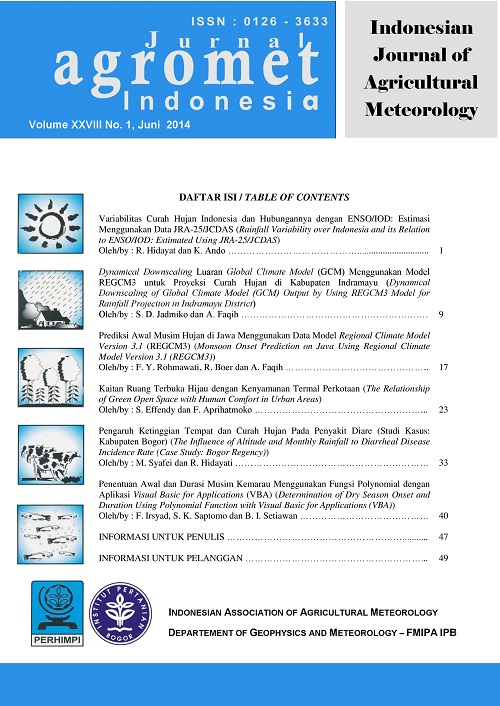Variabilitas Curah Hujan Indonesia dan Hubungannya dengan ENSO/IOD: Estimasi Menggunakan Data JRA-25/JCDAS
Abstract
Rainfall variability over Indonesia and its relation to El Niño – Southern Oscillation (ENSO) and the Indian Ocean Dipole (IOD) events were investigated using the Japanese 25-year reanalysis/Japan Meteorological Agency (JMA) Climate Data Assimilation System (JRA-25/ JCDAS). The JRA-25 data consistently depicts seasonal variation of Indonesian rainfall with a wet season that peaks at December-January and a dry season that peaks in July-August when the convection belt moved northward. Composite analysis of rainfall, sea surface temperature and low-level wind anomalies have shown that the impact of ENSO/IOD on rainfall variations in Indonesia is clearly dominant during dry season. Drought conditions typically occur during El Niño years when SST anomalies surrounding Indonesia are cool and walker circulation is weakened, resulting in anomalous surface easterlies across Indonesia. In contrast, in the wet season, the weakening of the relationship between ENSO and Indonesian rainfall is linked to the transition between surface southeasterlies to northwesterlies. At this time persistent surface easterly anomalies across Indonesia superimposed on the climatological mean winds during a warm phase of ENSO event acts to reduce the wind speed resulting reduced the negative DJF rainfall anomalies.
Authors
HidayatR., & AndoK. (2014). Variabilitas Curah Hujan Indonesia dan Hubungannya dengan ENSO/IOD: Estimasi Menggunakan Data JRA-25/JCDAS. Agromet, 28(1), 1-8. https://doi.org/10.29244/j.agromet.28.1.1-8

This work is licensed under a Creative Commons Attribution-NonCommercial 4.0 International License.

